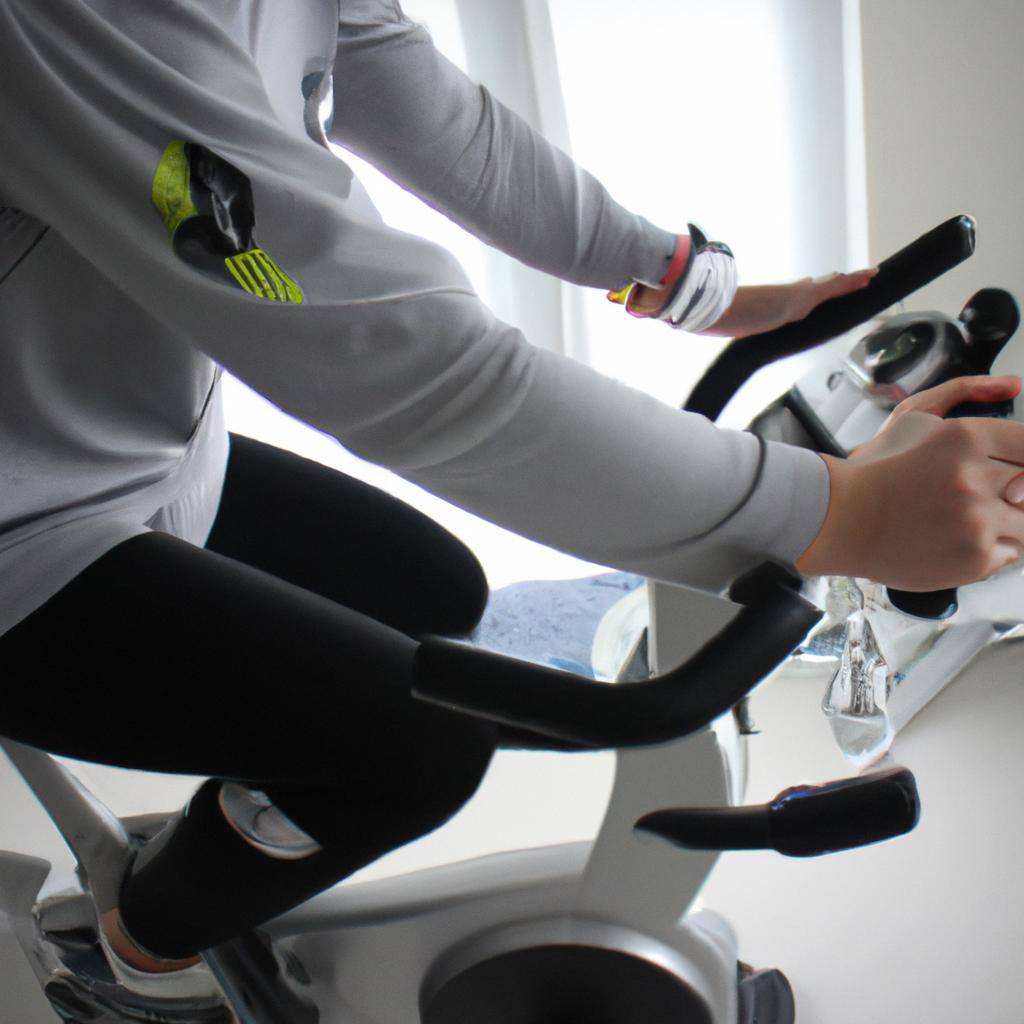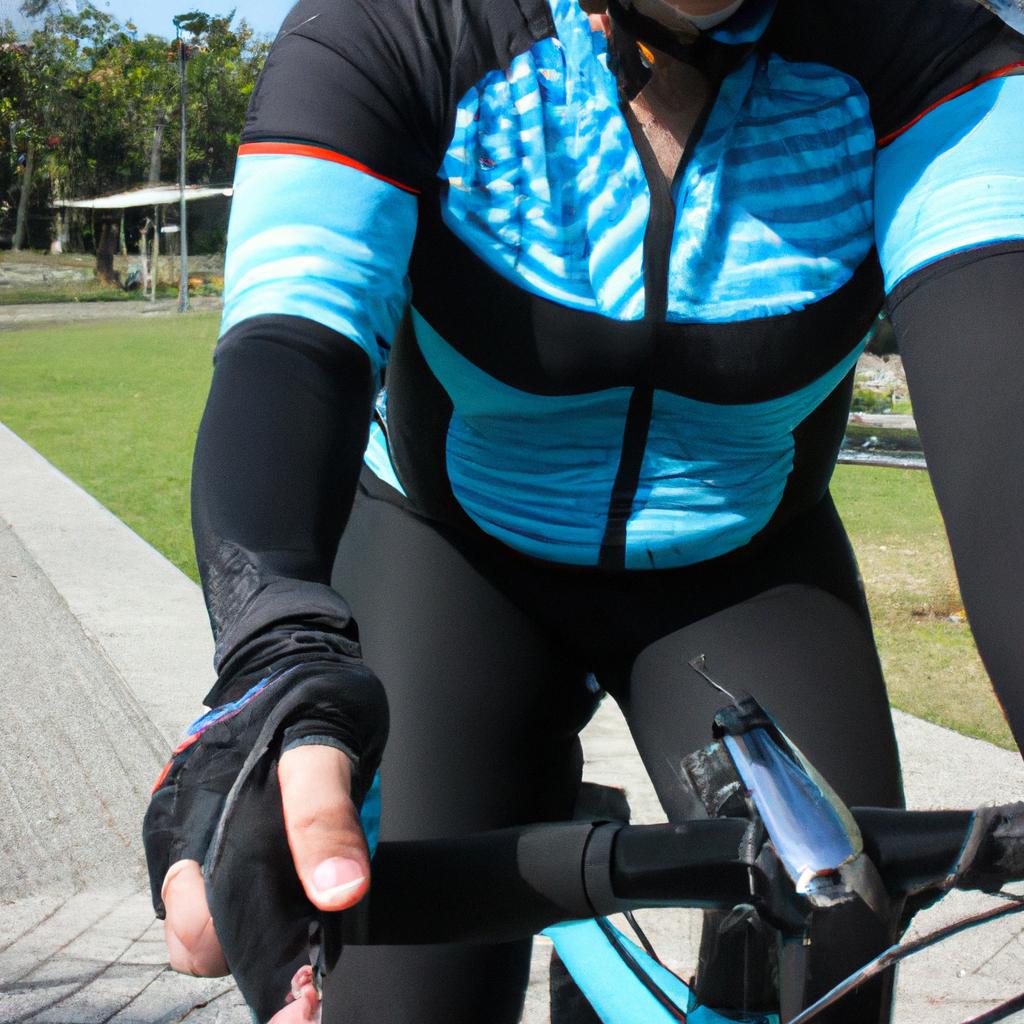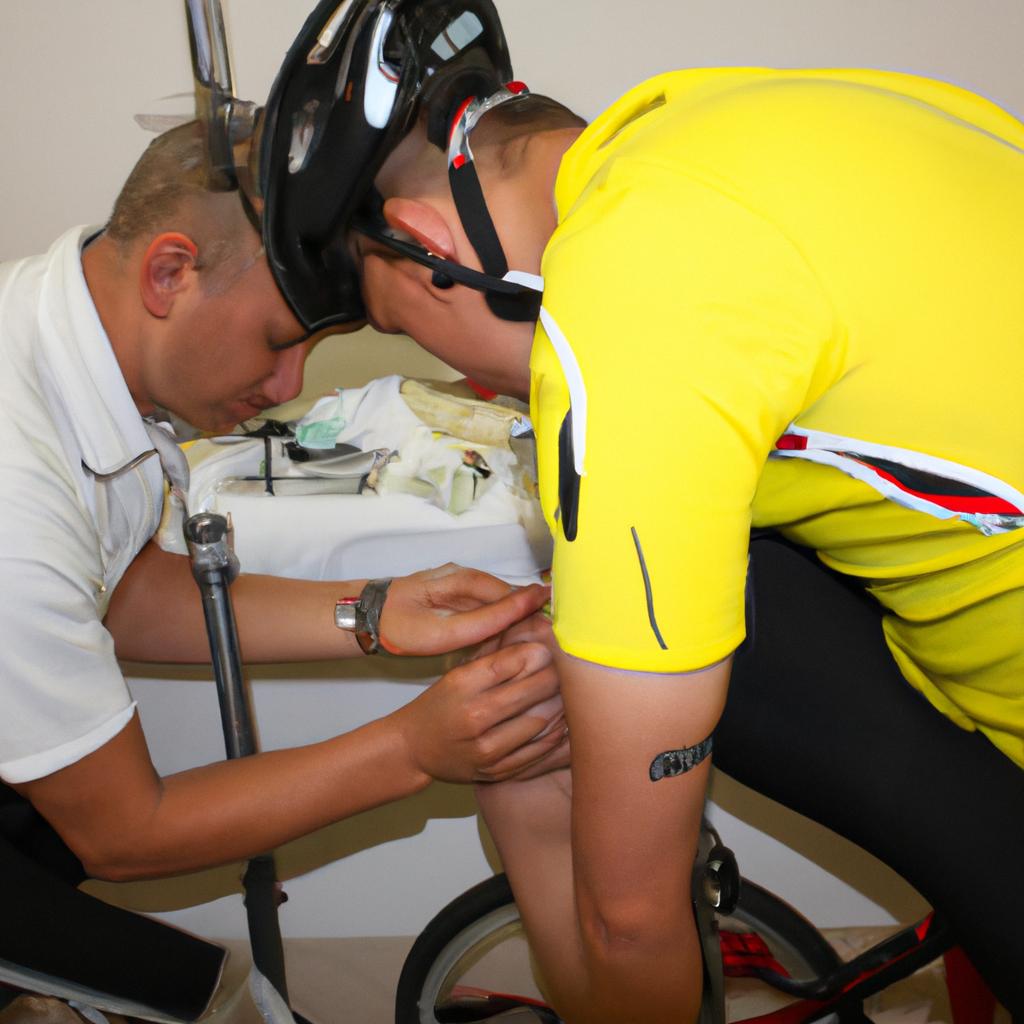Safety Tips: Cycling Injuries

Cycling is a popular form of transportation and recreational activity that provides numerous benefits for individuals of all ages. However, it also comes with inherent risks, as cycling injuries can range from minor scrapes to severe trauma. For instance, consider the case of John, a 45-year-old avid cyclist who was involved in a collision with a car while riding his bike on a busy city street. Despite wearing protective gear such as a helmet and reflective clothing, he sustained multiple fractures and required extensive medical treatment.
With the increasing popularity of cycling, it becomes imperative to address the issue of safety and minimize the risk of injuries associated with this activity. This article aims to explore various safety tips that can help cyclists prevent or mitigate potential harm. By understanding common causes of cycling accidents and implementing precautionary measures, individuals can enhance their overall safety while enjoying the many advantages that cycling has to offer. Whether you are an experienced rider or new to cycling, these guidelines will provide valuable insights into minimizing the likelihood of accidents and ensuring a safe biking experience for everyone on the road.
Helmet Safety
Helmet Safety
Imagine a scenario where a cyclist is involved in an accident while riding without wearing a helmet. The impact of the fall causes severe head injuries, resulting in long-term cognitive impairment and physical disabilities. This example highlights the importance of helmet safety when cycling.
To ensure maximum protection for cyclists, it is crucial to wear helmets that meet industry safety standards. A well-fitted helmet acts as a protective barrier, reducing the risk of head injuries in case of accidents or falls. Additionally, proper usage and maintenance are essential factors in ensuring the effectiveness of helmets.
To emphasize the significance of helmet safety further, consider these unsettling statistics:
- Nearly 70% of bicycle-related fatalities involve head injuries.
- Wearing a properly fitted helmet can reduce the risk of head injury by up to 85%.
- Children aged between five and fourteen years old represent one-third of all bicycle-related emergency department visits due to nonfatal injuries.
- In countries where helmet use is mandatory, there has been a significant decrease in cycling-related deaths and hospitalizations.
The following table provides key information on selecting and maintaining helmets:
| Key Considerations for Helmet Selection | |
|---|---|
| Fit | Ensure snug fit without wobbling |
| Size | Choose appropriate size based on head circumference |
| Certification | Look for recognized safety standards such as CPSC or ASTM |
| Replacement | Replace helmets after any crash or every five years |
By adhering to these guidelines, cyclists can significantly reduce their vulnerability to serious head injuries. Consequently, this underscores the importance of promoting helmet awareness campaigns and enforcing legislation regarding helmet use.
Transitioning into the subsequent section about “Proper Bike Fit,” understanding how helmets play a pivotal role in protecting cyclists lays the foundation for comprehending other critical aspects related to overall biking safety.
Proper Bike Fit
Transition:
Having discussed the importance of helmet safety in preventing cycling injuries, let us now turn our attention to another crucial aspect – proper bike fit. A well-fitted bicycle not only enhances comfort and performance but also reduces the risk of accidents and injuries.
Section: Proper Bike Fit
Example:
To illustrate the significance of proper bike fit, consider this hypothetical scenario: Sarah, an enthusiastic cyclist, recently purchased a new road bike. Eager to hit the roads, she embarked on her first long-distance ride without adjusting the bike’s components to suit her body proportions and riding style. As she strained to reach the handlebars that were too far away and struggled with pedals that were misaligned with her feet, Sarah experienced discomfort in her lower back and knees within just a few miles.
Paragraph 1:
Ensuring a proper bike fit involves several key elements. First and foremost is saddle height adjustment. When seated on the bike with one pedal at its lowest point, there should be a slight bend in your knee (around 25-30 degrees) rather than fully extended legs or excessive bending. This optimal position minimizes stress on your joints while maximizing power transfer during pedaling.
Next comes handlebar positioning. The handlebars should be positioned at a comfortable height where you can maintain a relaxed posture without straining your neck or shoulders. Additionally, make sure the width of the handlebars matches your shoulder width for better control and stability.
Paragraph 2:
Furthermore, appropriate cleat placement on cycling shoes plays a vital role in achieving optimum biking efficiency. Cleats are small metal or plastic attachments that connect your shoes to the pedals. Correct alignment ensures even distribution of force across each pedal stroke, reducing strain on specific muscles and joints such as the knees and ankles.
Finally, evaluating frame size is essential for overall comfort and maneuverability. Bicycles come in various frame sizes designed to accommodate different riders’ heights and body proportions. A frame that is too big or small can result in discomfort, compromised stability, and difficulty controlling the bike.
Bullet point list:
To achieve a proper bike fit, consider the following:
- Adequate saddle height for optimal pedaling efficiency.
- Handlebar positioning at a comfortable height to maintain posture.
- Proper cleat placement on cycling shoes for efficient power transfer.
- Choosing the appropriate frame size based on your body measurements.
Table:
| Bike Fit Component | Importance |
|---|---|
| Saddle Height | Optimal pedaling efficiency |
| Handlebar Positioning | Posture maintenance |
| Cleat Placement | Efficient power transfer |
| Frame Size | Comfort and control |
Paragraph 3:
By ensuring a proper bike fit through these key components – saddle height, handlebar positioning, cleat placement, and frame size evaluation – cyclists can significantly reduce their risk of injuries such as muscle strains, joint pain, and even long-term overuse issues. Adopting these practices not only enhances comfort during rides but also promotes safer cycling experiences overall.
Transition into subsequent section (Traffic Awareness):
In addition to helmet safety and proper bike fit, developing awareness of traffic conditions is paramount for every cyclist’s safety. Understanding how to navigate roads alongside other vehicles effectively will help minimize the risk of accidents while enjoying the benefits of cycling.
Traffic Awareness
Section H2: Proper Bike Fit
Having discussed the importance of proper bike fit in reducing cycling injuries, let us now turn our attention to another crucial aspect of safe cycling – traffic awareness. To better understand this concept, consider the following scenario: imagine a cyclist named Sarah who is riding her bicycle on a busy city street during rush hour.
Paragraph 1:
As Sarah navigates through the congested road, she faces numerous potential hazards that require her utmost attention and vigilance. The first key element of traffic awareness is understanding the rules of the road. This includes knowledge of local traffic laws and regulations specific to cyclists. For example, in many jurisdictions, bicycles are required to follow similar rules as motor vehicles, such as stopping at red lights and yielding to pedestrians when necessary.
To enhance safety while sharing the road with other vehicles, cyclists like Sarah should adopt defensive driving techniques. By assuming that motorists may not see them or anticipate their movements, cyclists can take proactive measures to avoid accidents. Maintaining a predictable path by staying within designated lanes and using hand signals when turning can help communicate intentions effectively.
- Maintain eye contact with drivers.
- Be cautious around parked cars.
- Use rearview mirrors for increased visibility.
- Avoid distractions such as headphones or cell phones.
Paragraph 2 (Bullet point list):
To emphasize the significance of traffic awareness in preventing cycling injuries, we present a brief bullet point list illustrating common sources of danger for cyclists:
- Distracted driving: Motorists preoccupied with mobile devices pose an immense risk to cyclists due to reduced reaction times.
- Intersection collisions: Failure to yield right-of-way or running red lights frequently leads to crashes between cyclists and vehicles.
- “Dooring” incidents: Opening car doors without checking for approaching bicyclists can result in severe accidents.
- Insufficient passing distance: When drivers pass too closely without allowing adequate space for cyclists, it increases the likelihood of side-swiping accidents.
Paragraph 3 (Table):
Furthermore, an analysis of cycling accident data further underscores the importance of traffic awareness. The table below highlights some alarming statistics:
| Type of Accident | Percentage of Cyclist Fatalities |
|---|---|
| Intersection | 45% |
| Right Hook | 15% |
| Dooring | 9% |
| Side Swipe | 6% |
These figures serve as a stark reminder that cyclist safety relies heavily on being aware of potential dangers posed by motor vehicles on the road.
Understanding and practicing proper hand signals is another critical aspect in ensuring safe cycling. By effectively communicating intentions with other road users, cyclists can significantly reduce the risk of collisions.
Hand Signals
Understanding the importance of traffic awareness is essential for cyclists to navigate through busy roads safely. By being aware of their surroundings and anticipating potential hazards, cyclists can significantly reduce the risk of accidents. Now, let’s delve deeper into some key strategies that can enhance traffic awareness.
Paragraph 1:
Imagine you are cycling on a narrow road with cars parked along the side. Suddenly, a car door swings open right in front of you without any warning. This scenario highlights one common issue faced by cyclists – the danger posed by opening car doors. To avoid such situations, it is crucial to maintain a safe distance from parked vehicles and be vigilant about any signs of movement inside them. Additionally, always ride at a moderate speed when passing rows of parked cars and be prepared to react quickly if necessary.
To improve your traffic awareness as a cyclist, consider the following:
- Stay focused and minimize distractions like using headphones or talking on the phone.
- Observe and interpret road signs and signals accurately.
- Maintain eye contact with drivers whenever possible to ensure they acknowledge your presence.
- Anticipate potential hazards by constantly scanning your surroundings.
| Strategies for Enhancing Traffic Awareness |
|---|
| Be alert and attentive at all times |
| Understand and obey traffic regulations |
| Maintain clear visibility through proper lighting and reflective gear |
| Practice defensive riding techniques |
Paragraph 2:
In addition to implementing specific strategies, understanding typical driver behaviors can also contribute to better traffic awareness. For instance, many motorists tend to underestimate the speed of bicycles or fail to anticipate their movements accurately. As a cyclist, it is important to anticipate these misconceptions while sharing the road with motorized vehicles. Predictability plays an integral role in enhancing safety; thus, clearly signaling lane changes or turns well in advance enables drivers behind you to adjust their speed accordingly.
Paragraph 3:
Developing good traffic awareness is an ongoing process that requires consistent practice and adaptation. By adopting a proactive approach and being mindful of potential risks, cyclists can mitigate the likelihood of accidents on the road. In the following section about “Road Conditions,” we will explore how to navigate various terrains while maintaining optimal safety standards.
Building strong traffic awareness skills is essential, but understanding the impact of different road conditions is equally important for safe cycling journeys. Let’s now shift our focus to exploring strategies for navigating diverse terrain in order to continue prioritizing your safety on two wheels.
Road Conditions
Moving on from understanding hand signals, it is crucial for cyclists to be aware of the various road conditions they may encounter during their rides. By being knowledgeable about potential hazards and adapting their cycling techniques accordingly, cyclists can significantly reduce the risk of accidents and injuries.
Example: For instance, let’s consider a hypothetical scenario where a cyclist encounters a pothole while riding downhill at high speed. Without prior knowledge or preparation, this unexpected obstacle could cause the cyclist to lose control and potentially result in a serious accident.
To ensure safety on the road, here are some important factors related to road conditions that every cyclist should keep in mind:
- Surface Quality:
- Smooth surfaces provide better traction and stability.
- Rough roads with cracks, debris, or uneven pavement increase the chances of losing balance.
- Wet or icy surfaces can lead to reduced grip and increased braking distance.
- Gravel or loose dirt poses an additional challenge by making it more difficult to maintain control over the bicycle.
In addition to surface quality, cyclists must also pay attention to other aspects of road conditions such as:
-
Traffic Volume:
- High traffic areas demand extra caution due to increased interaction with vehicles.
- Busy intersections require careful navigation using appropriate hand signals and eye contact with drivers.
-
Obstructions:
- Parked cars, pedestrians stepping onto bike lanes without warning, or open car doors pose significant risks if not anticipated promptly.
- Road construction sites or temporary barriers can obstruct regular cycling routes.
By staying vigilant and taking necessary precautions based on these factors, cyclists can minimize the likelihood of accidents caused by unfavorable road conditions.
Understanding how different road conditions impact cycling safety leads us to another critical aspect – protective gear. The right equipment plays a vital role in shielding cyclists from potential harm and enhancing their overall safety on the road.
Protective Gear
Transitioning from the previous section on road conditions, it is crucial to discuss the importance of protective gear when cycling. Consider this hypothetical scenario: John, an avid cyclist, was riding his bike downhill at high speeds when suddenly he lost control and fell off his bicycle. As a result, he suffered severe injuries including multiple fractures and head trauma. This unfortunate incident highlights the significance of wearing appropriate protective gear while cycling.
To ensure your safety on the road, here are some essential pieces of protective equipment you should consider:
-
Helmet:
- Provides protection for your head and reduces the risk of serious brain injury.
- Must fit properly and be securely fastened under your chin.
- Look for helmets that meet recognized safety standards such as CPSC or EN 1078.
-
Knee Pads and Elbow Guards:
- Offer added protection against abrasions, cuts, and fractures during falls.
- Should fit snugly without restricting movement.
- Opt for padded knee pads with hard-shell caps for enhanced protection.
-
Reflective Clothing:
- Increases visibility to motorists in low-light conditions or at night.
- Choose brightly colored clothing with reflective strips or patches.
- Wear a reflective vest or jacket over your regular attire.
-
Gloves:
- Provide grip on handlebars and protect hands from scrapes if you fall.
- Select gloves with padding on the palms to absorb shocks.
Incorporating emotional elements into this discussion further emphasizes the importance of protective gear:
| Emotional Impact | |
|---|---|
| 1. | Traumatic accidents can lead to life-altering consequences |
| 2. | Visualize being involved in an accident without proper protection |
| 3. | Realize the potential financial burden of medical expenses and rehabilitation |
| 4. | Imagine the emotional toll on loved ones if you were seriously injured |
By incorporating these safety measures into your cycling routine, you can significantly reduce the risk of severe injuries. Remember that accidents can happen to even the most experienced cyclists, so it is crucial to prioritize your safety by wearing appropriate protective gear.
In summary, protecting yourself while cycling is paramount for injury prevention. By investing in quality protective equipment such as helmets, knee pads, elbow guards, reflective clothing, and gloves, you enhance your safety on the road. Stay vigilant and ensure all gear fits properly before embarking on any cycling adventure.






